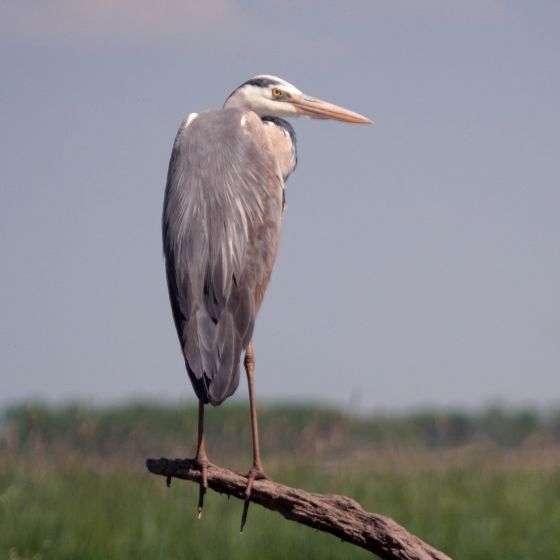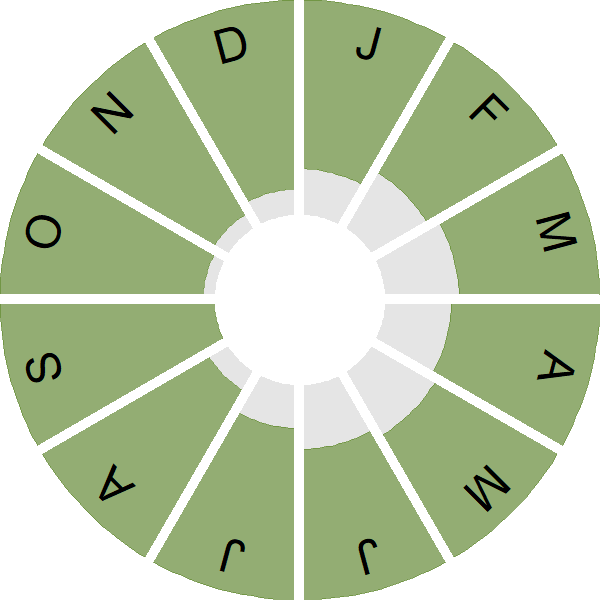Grey Heron

Introduction
The Grey Heron is a distinctive species with grey, black, and white plumage. It is often seen along rivers or lake margins, or standing in flooded fields.
In flight their large size, impressive wingspan, long legs, and folded neck give them an unmistakable silhouette. Largely silent away from colonies, flight is sometimes accompanied by a harsh 'kraank' call.
Grey Herons gather to nest in treetop sites called heronries, some of which have been occupied for many decades. These have been monitored in the UK since 1928 through the Heronries Census. Overall the UK's breeding population has increased, with numbers peaking in the early 2000, but with some more recent declines.
- Our Trends Explorer gives you the latest insight into how this species' population is changing.

Key Stats
Identification
Songs and Calls
Call:
Alarm call:
Flight call:
Status and Trends
Conservation Status
Population Change
The BTO Heronries Census, which has monitored Grey Herons since 1928, shows the species to have been more abundant in the early 2000s than at any time in the last 90 years. In the full survey of UK heronries, carried out in 2003 to mark the 75th anniversary of the Heronries Census, a record total of more than 10,441 Grey Heron nests were counted, around 75% of the estimated total population for that year. In the most recent full survey in 2018, a higher number of sites were visited than in 2003 but fewer nests were counted, reflecting a subsequent downturn.
Wintering numbers, which include some Scandinavian breeders, fell between 2006/07 and 2012/13, but have since been broadly stable, mirroring the heronries census trend (WeBS: Frost et al. 2020). Numbers have increased across Europe since 1980 (PECBMS: PECBMS 2020a>).
Distribution
Grey Herons are widely distributed across Britain & Ireland except for the most mountainous areas.
Occupied 10-km squares in UK
or view it on Bird Atlas Mapstore.
or view it on Bird Atlas Mapstore.
European Distribution Map
Distribution Change
Some distribution gains may be attributed to improved coverage, whilst others may relate to true population increases.
Change in occupied 10-km squares in the UK
or view it on Bird Atlas Mapstore.
or view it on Bird Atlas Mapstore.
Seasonality
Grey Herons are present year-round and recorded on up to 30% of complete lists.
Weekly pattern of occurrence
The graph shows when the species is present in the UK, with taller bars indicating a higher likelihood of encountering the species in appropriate regions and habitats.

Habitats
Breeding season habitats
Relative frequency by habitat
The graph shows the habitats occupied in the breeding season, with the most utilised habitats shown at the top. Bars of similar size indicate the species is equally likely to be recorded in those habitats.

Movement
Britain & Ireland movement
Foreign locations of birds ringed or recovered in Britain & Ireland
Dots show the foreign destinations of birds ringed in Britain & Ireland, and the origins of birds ringed overseas that were subsequently recaptured, resighted or found dead in Britain & Ireland. Dot colours indicate the time of year that the species was present at the location.
- Winter (Nov-Feb)
- Spring (Mar-Apr)
- Summer (May-Jul)
- Autumn (Aug-Oct)

European movements
EuroBirdPortal uses birdwatcher's records, such as those logged in BirdTrack to map the flows of birds as they arrive and depart Europe. See maps for this species here.
The Eurasian-African Migration Atlas shows movements of individual birds ringed or recovered in Europe. See maps for this species here.
Biology
Productivity and Nesting
Nesting timing
Egg measurements
Clutch Size
Incubation
Fledging
Survival and Longevity
Survival is shown as the proportion of birds surviving from one year to the next and is derived from bird ringing data. It can also be used to estimate how long birds typically live.
View number ringed each year in the Online Ringing Report.
lifespan
Survival of adults
Survival of juveniles
Biometrics
Wing length and body weights are from live birds (source).
Ring Size
Classification, names and codes
Classification and Codes
- Order: Pelecaniformes
- Family: Ardeidae
- Scientific name: Ardea cinerea
- Authority: Linnaeus, 1758
- BTO 2-letter code: H.
- BTO 5-letter code: GREHE
- Euring code number: 1220
Alternate species names
- Catalan: bernat pescaire
- Czech: volavka popelavá
- Danish: Fiskehejre
- Dutch: Blauwe Reiger
- Estonian: hallhaigur
- Finnish: harmaahaikara
- French: Héron cendré
- Gaelic: Corra-ghritheach
- German: Graureiher
- Hungarian: szürke gém
- Icelandic: Gráhegri
- Irish: Corr Réisc
- Italian: Airone cenerino
- Latvian: zivju garnis
- Lithuanian: pilkasis garnys
- Norwegian: Gråhegre
- Polish: czapla siwa
- Portuguese: garça-moura-europeia / garça-real
- Slovak: volavka popolavá
- Slovenian: siva caplja
- Spanish: Garza real
- Swedish: gråhäger
- Welsh: Crëyr Glas
- English folkname(s): Harnser, Frank
Research
Causes of Change and Solutions
Causes of change
There has been no change in the number of fledglings per breeding attempt, hence the population increases most likely relate to increased survival of adults and/or immature birds. The ecological reasons behind these changes are unclear.
Further information on causes of change
The effects of harsh winters, which induce severe mortality in this species (Besbeas et al. 2002), are clearly visible in the long-term trend. The general increase that underlies these fluctuations may stem from reduced persecution, improvements in water quality, the provision of new habitat as new lakes and gravel pits mature, and increased feeding opportunities at freshwater fisheries (Gibbons et al. 1993, Marchant et al. 2004). The strong downturn between 2005 and 2013 is, as yet, unexplained, but could be linked to cold winter weather and spring gales. High rates of nest failure at the chick stage were noted in the late 1960s, but not subsequently. Clutch and brood sizes have fallen in the long term but the number of fledglings per breeding attempt has not changed.
Information about conservation actions
A reduction in the frequency of cold winters may have benefited this species, as well as improvements in water quality and the provision of new wetland habitats. Ongoing conservation action to help provide habitat for other wetland species is therefore also likely to help the Grey Heron. Heronries can sometimes be located some distance from wetland sites and hence actions to ensure that key sites are protected and to prevent disturbance may also be helpful, although there is no evidence currently to suggest any problems occur during the breeding season.
Conflicts with anglers and aquaculture may occur in future, particularly if numbers pick up again after the recent slight downturn. Therefore, policy decisions may need to be made to ensure Grey Heron populations are protected whilst minimising conflict.

